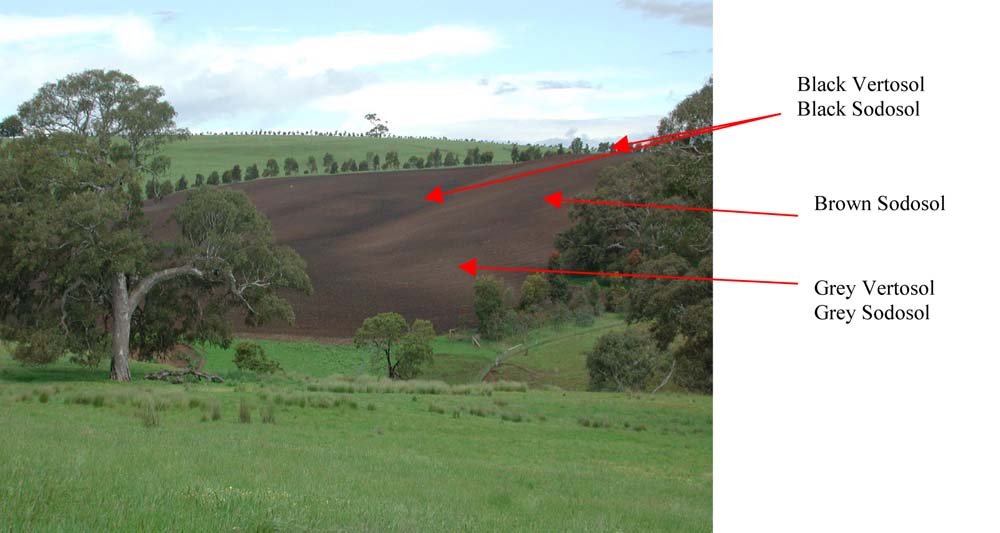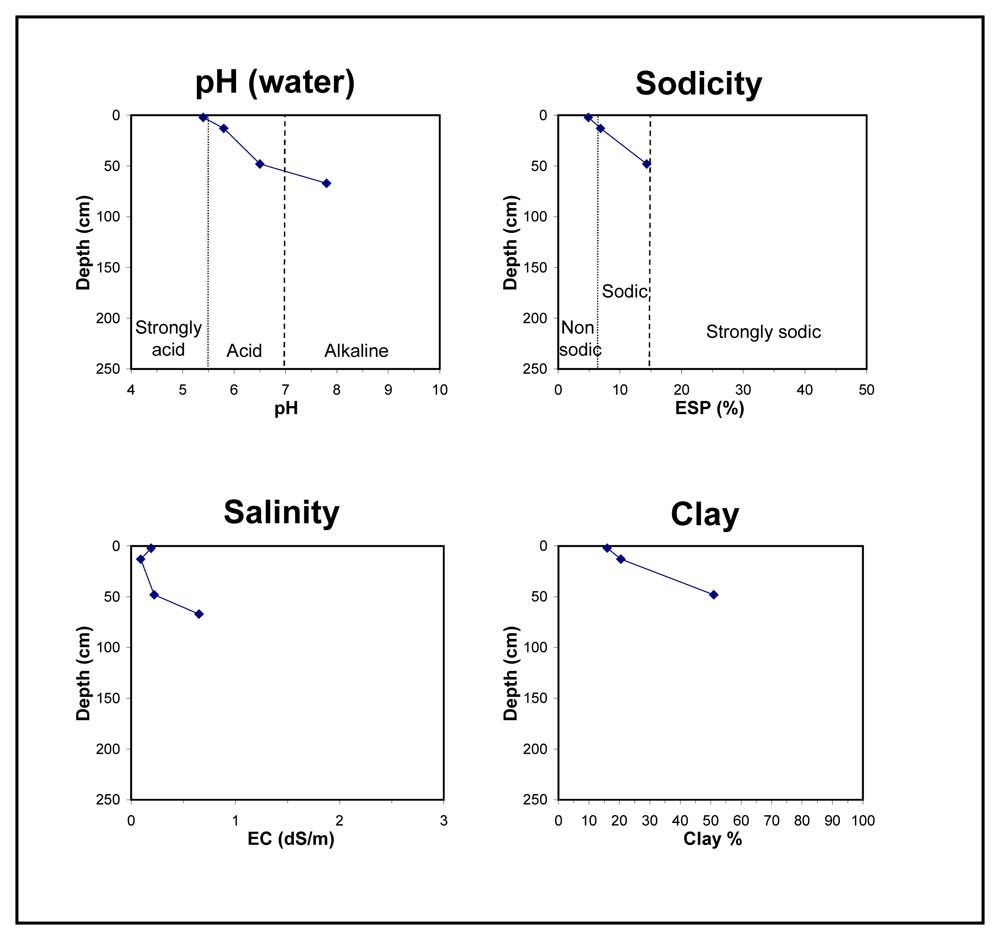GL12
Location: Nangella
Australian Soil Classification: Vertic, Subnatric, Brown SODOSOL (confidence level 1)
General Landscape Description: Rolling low hills and rises
Site Description: Lower 12 % slope
Land Unit: Merino Tablelands
Geology: Cretaceous non-marine sandstone
General Land Unit Description: This unit consists of the Cretaceous non-marine sandstone of the dissected Merino Tablelands. The tablelands were thought to have formed under swamp conditions and a warm climate. As a result, the soils tend to be high in clay and there tends to be carbon rich seams of charcoal deposits at depth in some of the profiles. The main soil type used to represent this land unit is black cracking clays (Vertosols) that can be sodic at depth. This soil type, along with Black Sodosols, Chromosols and Dermosols, are commonly found on the broad crests or drainage lines. The slopes often consist of Brown Chromosols, Sodosols or Dermosols, although black soils can also occur on the slopes. The lower slopes commonly have Grey Vertosols or Sodosols as the major soil type. The reasonably deep sodic soils on short steep slopes tend to be prone to landslips. The grey soils, in particular are prone to water erosion.

Soil Profile Morphology
| A1 | 0-5 cm | Very dark greyish brown (10YR3/2); sandy loam; weak fine subangular blocky structure; weak consistence, dry; pH 5.4; changes to:
|
| A2 | 5-35 cm | Dark brownish grey (10YR4/2); fine sandy clay loam; massive structure; very firm consistence, dry; contains very few ferruginised nodules; pH 5.8; changes to:
|
| Subsoil
| ||
| B2 | 35-70 cm | Dark brown (10YR3/3), with very few faint yellow mottles from oxidised roots; medium clay; strong lenticular structure; very strong consistence, dry; pH 6.5; gradual change to:
|
| B3 | 70-90 cm | Dark brown (10YR3/3); light clay; very strong consistence, dry; organic staining present; pH 7.8. |
Key profile features:
- Acidic topsoil
- Sodic subsoil
- Top of the subsoil dispersive when worked when wet
Soil Profile Characteristics:
- | pH | Salinity | ||
Surface Soil (A1 horizon) | Strongly Acid | Medium | Non-Sodic | None |
Subsoil (35-70 cm) | Slightly Acid | Low | Sodic | None1 |
Deeper Subsoil (45 -60 cm) | Slightly Alkaline | High | - | - |

Chemical and Physical Analysis:
Horizon | Horizon Depth (cm) | pH (water) | pH (CaCl2) | EC dS/m | Organic Carbon % | Total Nitrogen % | Exchangeable Aluminium ppm | Exchangeable Acididty meq/100g | Exchangeable Cations | Coarse Sand (0.2-2.0 mm) % | Fine Sand (0.02-0.2 mm) % | Silt (0.002-0.02 mm) % | Clay (<0.002 mm) % | Field Capacity % w/w | Wilting Point % w/w | |||
Ca | Mg | K | Na | |||||||||||||||
meq/100g | ||||||||||||||||||
A1 | 0-5 | 5.4 | 4.6 | 0.19 | 3.1 | 0.27 | 16 | 10 | 2.2 | 1.9 | 0.74 | 0.76 | 31 | 32 | 14 | 16 | 23.3 | 8.6 |
A2 | 5-35 | 5.8 | 4.6 | 0.09 | 32 | 6.7 | 1.3 | 2.2 | 0.41 | 0.78 | 30 | 32 | 17 | 21 | 20.4 | 7.7 | ||
B2 | 35-70 | 6.5 | 5.3 | 0.22 | 11 | 4.3 | 9.8 | 0.96 | 4.3 | 14 | 18 | 16 | 51 | 45.1 | 23.3 | |||
B3 | 70-90 | 7.8 | 7.0 | 0.65 | ||||||||||||||
Profile Described By: Grant Boyle and Natalie Baxter, 1st October 2000.


